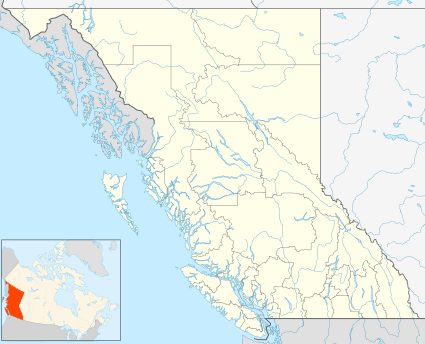Pleasant Camp, British Columbia
Pleasant Camp is a government facility in the remote Atlin District of northwestern British Columbia, Canada at an elevation of 274.3 meters. It is a federal government camp servicing the Port of Pleasant Camp and offers no public amenities.

The Port of Pleasant Camp is on the Haines Highway/Yukon #3 Highway and is a border crossing between the USA and Canada. The port of entry to the U.S., about 300 yards to the south of Pleasant Camp, is named Dalton Cache.
Pleasant Camp has one of the highest snowfall totals in Canada.[1]
In 2017 the population was counted as 10 people but can fluctuate between 4 and 16.
Local wildlife varies with many visits from black bear, porcupine, eagles and moose.
Climate
Pleasant Camp has a dry-summer subarctic climate (Köppen climate classification: Dsc), though it is extremely atypical of the type in its pronounced summer precipitation minimum, very heavy autumn rainfall, and extreme winter snowfall. The climate is basically, in fact, a cooler and snowier version of the climate found in the mildly shielded southeast Alaskan towns of Juneau and Haines, though the colder winters mean snowfall is among the heaviest on North America at around 7.4 metres (290 in).
Extreme minima are much milder than in interior British Columbia: temperatures have never reached −35 °C (−31 °F) whereas Prince George and Fort St. John though further south have reached −50 °C (−58 °F) during extreme cold periods.
| Climate data for Pleasant Camp | |||||||||||||
|---|---|---|---|---|---|---|---|---|---|---|---|---|---|
| Month | Jan | Feb | Mar | Apr | May | Jun | Jul | Aug | Sep | Oct | Nov | Dec | Year |
| Record high °C (°F) | 7.5 (45.5) |
11.5 (52.7) |
13.5 (56.3) |
20.0 (68.0) |
25.0 (77.0) |
30.5 (86.9) |
32.8 (91.0) |
34.0 (93.2) |
24.5 (76.1) |
18.0 (64.4) |
10.0 (50.0) |
6.5 (43.7) |
34.0 (93.2) |
| Average high °C (°F) | −5.0 (23.0) |
−1.9 (28.6) |
1.8 (35.2) |
7.4 (45.3) |
13.6 (56.5) |
18.3 (64.9) |
19.9 (67.8) |
18.3 (64.9) |
12.6 (54.7) |
5.6 (42.1) |
−1.9 (28.6) |
−3.7 (25.3) |
7.1 (44.8) |
| Daily mean °C (°F) | −7.9 (17.8) |
−5.4 (22.3) |
−2.3 (27.9) |
2.7 (36.9) |
7.8 (46.0) |
12.3 (54.1) |
14.5 (58.1) |
13.3 (55.9) |
8.7 (47.7) |
2.8 (37.0) |
−4.6 (23.7) |
−6.4 (20.5) |
3.0 (37.4) |
| Average low °C (°F) | −10.8 (12.6) |
−8.9 (16.0) |
−6.3 (20.7) |
−2.0 (28.4) |
2.0 (35.6) |
6.2 (43.2) |
9.1 (48.4) |
8.3 (46.9) |
4.7 (40.5) |
0.1 (32.2) |
−7.3 (18.9) |
−9.0 (15.8) |
−1.2 (29.8) |
| Record low °C (°F) | −32.0 (−25.6) |
−31.1 (−24.0) |
−27.0 (−16.6) |
−17.5 (0.5) |
−5.0 (23.0) |
−2.0 (28.4) |
0.5 (32.9) |
0.5 (32.9) |
−8.5 (16.7) |
−19.0 (−2.2) |
−31.0 (−23.8) |
−32.2 (−26.0) |
−32.2 (−26.0) |
| Average precipitation mm (inches) | 200.4 (7.89) |
139.1 (5.48) |
106.2 (4.18) |
69.7 (2.74) |
51.9 (2.04) |
37.4 (1.47) |
35.8 (1.41) |
72.4 (2.85) |
148.8 (5.86) |
188.1 (7.41) |
160.0 (6.30) |
217.3 (8.56) |
1,426.9 (56.18) |
| Average rainfall mm (inches) | 35.0 (1.38) |
27.8 (1.09) |
23.6 (0.93) |
48.9 (1.93) |
49.4 (1.94) |
37.4 (1.47) |
35.8 (1.41) |
72.4 (2.85) |
148.0 (5.83) |
153.0 (6.02) |
32.0 (1.26) |
39.8 (1.57) |
703.1 (27.68) |
| Average snowfall cm (inches) | 165.4 (65.1) |
111.4 (43.9) |
82.6 (32.5) |
20.8 (8.2) |
2.6 (1.0) |
0.0 (0.0) |
0.0 (0.0) |
0.0 (0.0) |
0.8 (0.3) |
35.0 (13.8) |
128.0 (50.4) |
177.4 (69.8) |
723.8 (285.0) |
| Average precipitation days (≥ 0.2 mm) | 17.3 | 13.5 | 11.7 | 11.9 | 12.3 | 11.3 | 11.9 | 16.0 | 19.4 | 20.7 | 15.3 | 18.5 | 179.9 |
| Average rainy days (≥ 0.2 mm) | 2.7 | 2.4 | 4.0 | 9.4 | 12.1 | 11.3 | 11.9 | 16.0 | 19.4 | 17.8 | 3.0 | 3.9 | 114.0 |
| Average snowy days (≥ 0.2 cm) | 16.0 | 12.2 | 9.4 | 4.2 | 0.5 | 0.0 | 0.0 | 0.0 | 0.4 | 5.0 | 13.1 | 16.7 | 77.5 |
| Source: [2] | |||||||||||||
References
- "Jim Garry's Guide to British Columbia" by Jim Garry
- "Calculation Information for 1981 to 2010 Canadian Normals Data". Environment Canada. Archived from the original on 17 February 2014. Retrieved 9 July 2013.